
| KIT #: | 12003 |
| PRICE: | $15.00 |
| DECALS: | Four options |
| REVIEWER: | Ryan Grosswiler |
| NOTES: | Also available under Eastern Express and Modelist labels |

| HISTORY |
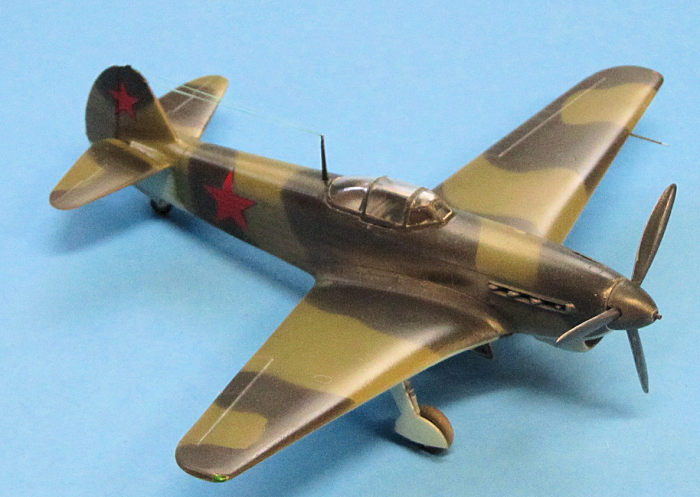
The Yak 1-9 family of fighters are without a doubt the single most undersung Allied aircraft of the Second World War, with some thirty-thousand built. They can also be very difficult to distinguish from each other, like late B-24s and Bf-109s, so I will lay it out as best I can. Broad brush strokes, mind you:
Yak-1, -7, and -9 were all sequential derivatives of same basic airframe, the original mixed-construction wood, steel-tube, and fabric Yak I-26 prototype from 1940. The Yak-1 "There's a Big War coming and everyone's whipping out single-engine closed-canopy fighters. Here's ours!" was essentially similar to the prototype with numerous minor detail refinements, particularly as production progressed. Never really satisfactory as a fighter, it likely remained in production and service owing to pressing need, Alexander Yakovlev's favored status with Stalin, and the fact that it was at least a little better than the yucky LaGG-3. 8,700 built.
The Yak-7 "We tried to make a trainer out of it but instead made a better fighter" began life as a two-seat advanced instructional modification of the Yak-1, with the wing moved 8" aft, a second cockpit added over the wing trailing edge, an enlarged and more rectangular radiator moved mid-chord from the wing trailing edge, and totally new main landing gear angled further forward. Some trainer/liaison blocks were built with fixed landing gear. Though the Soviets were pioneers in creating training aircraft by modifying single-seat fighters in this manner, immediately it was discovered that the alterations in CG greatly stabilized the aircraft, making it a far superior gun platform compared to the Yak-1, and also less prone to spin. The majority were therefore built as fighters with the aft cockpit left empty and associated canopy painted over. 6,400 built.
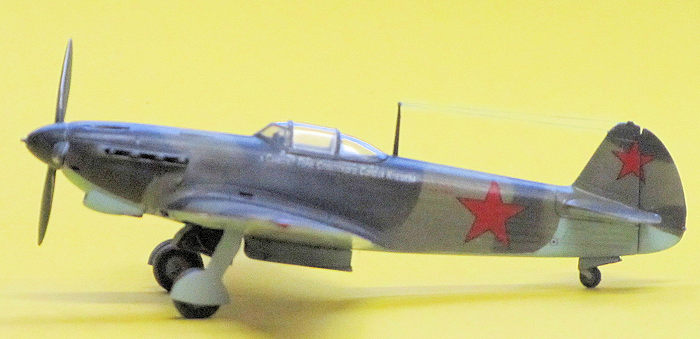 The Yak-9 "let's refine it in every conceivable way!" was continued development
of the single-seat Yak-7 fighter, with lighter construction stemming from
more extensive use of duralumin, new squarish wingtips, and a cut-down rear
fuselage featuring an all-round vision canopy. Later aircraft had the cockpit
moved aft to a position over the wing trailing edge. 16,800 built.
The Yak-9 "let's refine it in every conceivable way!" was continued development
of the single-seat Yak-7 fighter, with lighter construction stemming from
more extensive use of duralumin, new squarish wingtips, and a cut-down rear
fuselage featuring an all-round vision canopy. Later aircraft had the cockpit
moved aft to a position over the wing trailing edge. 16,800 built.
For a period in 1944 all three were in production at the same time, and to make things more confusing, late examples of both the -7 and -1 would gain the -9's canopy and cut-down rear fuselage. So the only way to tell them apart is to spot the straight, two-piece main landing gear doors of the -1, the angled-forward main gear combined with round wingtips of the -7, and the more squared wingtips of the -9.
What the Yak 1/7/9 isn't: The Yak-3 lightweight was in fact a totally different design developed in parallel with the other three, slightly smaller in all dimensions, identifiable by its one-piece molded windscreen and lack of an oil cooler under the nose. Late war/postwar Yak-9 U and P were also largely different airplanes, mostly metal and also lacking the cooler under the nose, the final development from lessons learned from all previous Yak fighters. Aside from about twenty Yak-3s built to original specs (except the necessary Allison engines) by the Yakovlev bureau in the '90s, the "Yak fighters" you see on the airshow circuit these days are kluged-together approximations often using the postwar radial-engined Yak-11 trainer as a starting point. Thanks to Stalin's zealous cleanup efforts, there are only one or two actual wartime survivors of that huge number built, though a few recovered wrecks are beginning to progress through restoration shops at this writing.
| THE KIT |
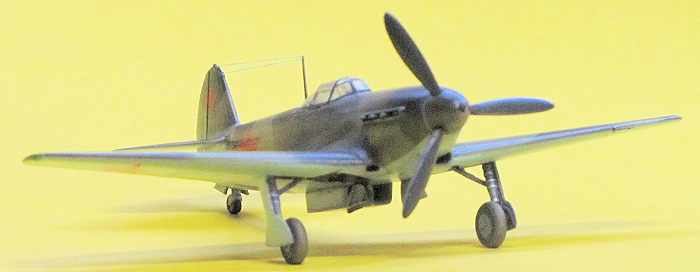 t 1994, also released by Alanger and
Encore. Still with problems, mainly heavy-handed detail/trench scribing
and a canopy too shallow and one scale foot thick.
t 1994, also released by Alanger and
Encore. Still with problems, mainly heavy-handed detail/trench scribing
and a canopy too shallow and one scale foot thick.| CONSTRUCTION |
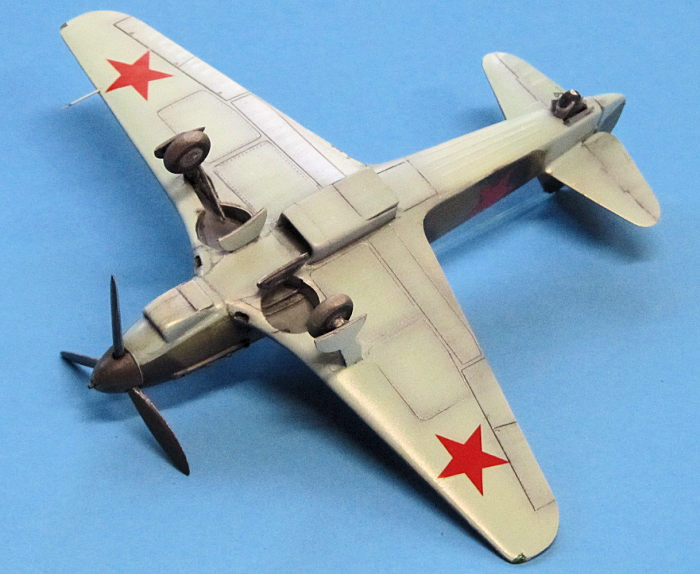 As usual, I started by rejecting the injected canopy in favor of a vacuform
one (by Pavla, intended for the A Model kit) and fitted the fuselage halves
together with this canopy and glued in the cockpit floor and bulkheads. Some
additional cockpit detail and lead-foil seatbelts went in, too. I refined
the detail around the armament, including drilling out the single gun port
(yes, just one) up top and the cannon muzzle in the spinner, and adding
blast tubes from Albion Alloys brass to both. I refined the shape of the gun
breech fairing and added a roof to the shell-ejection port. Engraved wing
root cabin air intakes were chiseled out (though these could be closed by a
door in flight: so the recessed detail is accurate). Missing stringer detail
was depicted on the aft fuselage underside with lines of Tamiya tape
masking, primer brushed on in three coats, tape removed, and raised ridges
gently sanded down to subtlety.
As usual, I started by rejecting the injected canopy in favor of a vacuform
one (by Pavla, intended for the A Model kit) and fitted the fuselage halves
together with this canopy and glued in the cockpit floor and bulkheads. Some
additional cockpit detail and lead-foil seatbelts went in, too. I refined
the detail around the armament, including drilling out the single gun port
(yes, just one) up top and the cannon muzzle in the spinner, and adding
blast tubes from Albion Alloys brass to both. I refined the shape of the gun
breech fairing and added a roof to the shell-ejection port. Engraved wing
root cabin air intakes were chiseled out (though these could be closed by a
door in flight: so the recessed detail is accurate). Missing stringer detail
was depicted on the aft fuselage underside with lines of Tamiya tape
masking, primer brushed on in three coats, tape removed, and raised ridges
gently sanded down to subtlety.
One minor annoyance I noticed with completed models spotted online is that the main landing gear looks way too bulky to ever stand a chance of fitting into their shallow wells. This is a combination of injection molding limitations, axles too long, and main wheels much too fat. I felt this needed correction, so improved the look by 1) sanding a little off the main gear legs where they mated with the gear doors to slim the assembly, 2) trimming the axles back to stubs, and 3) using skinnier resin aftermarket wheels (alternatively, you can simply sand the wheels halves taking about 1mm from each before assembly). Mine came from the ResKit range.
| COLORS & MARKINGS |
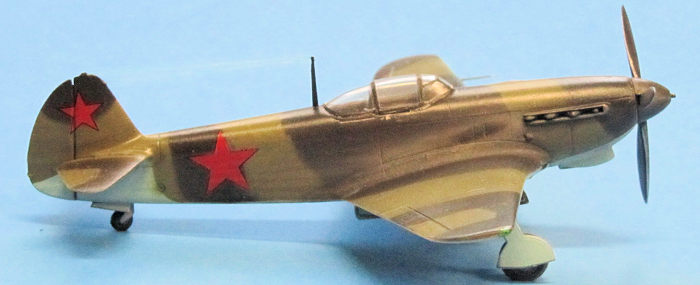 Though there are a variety of interesting schemes possible for this
fighter, I decided not to go that way this time. Mine's just another bland
black-on-olive-green Soviet fighter, one of the first Yak-9s arriving at the
front right in time for Stalingrad. Anonymous, except for an unusually small
slogan beneath the cockpit. I asked my wife, a once-fluent Russian speaker,
to translate: "Hmmm...Airplane Hero of Soviet with...Gumption? Bell-Bottoms?
Courage?"
Though there are a variety of interesting schemes possible for this
fighter, I decided not to go that way this time. Mine's just another bland
black-on-olive-green Soviet fighter, one of the first Yak-9s arriving at the
front right in time for Stalingrad. Anonymous, except for an unusually small
slogan beneath the cockpit. I asked my wife, a once-fluent Russian speaker,
to translate: "Hmmm...Airplane Hero of Soviet with...Gumption? Bell-Bottoms?
Courage?"
I kept weathering to a minimum, only a light wash and a pair of exhaust streaks to indicate a zealously-leaned engine. In taking the photos I also noticed that I'd neglected to depict the prominent fuel gauges on the wings. I'll have to fix that.
| CONCLUSIONS |
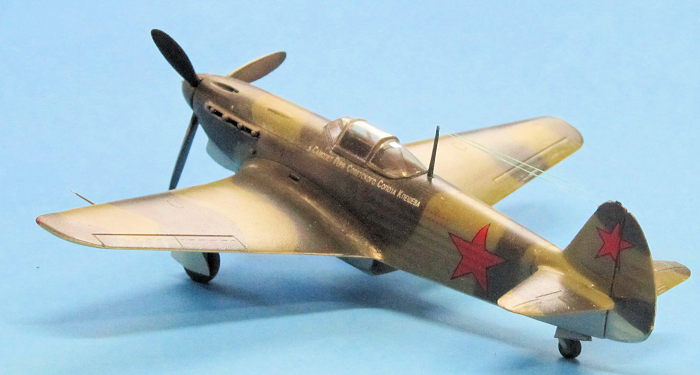 Thoroughly enjoyable. Kits like this are a nice transition from mainstream
injected products to the dark, menacing world of limited-run plastic.
Twenty-plus years on, still the best kit of this classic aircraft in 1/72.
If this kind of thing is your bag, baby, find one under whatever label and
enjoy it. They'll probably pop up again before too long in the retail world.
Thoroughly enjoyable. Kits like this are a nice transition from mainstream
injected products to the dark, menacing world of limited-run plastic.
Twenty-plus years on, still the best kit of this classic aircraft in 1/72.
If this kind of thing is your bag, baby, find one under whatever label and
enjoy it. They'll probably pop up again before too long in the retail world.
One of the geeky little side-benefits to building in constant-scale is seeing these planes in comparison to one another--it's interesting to see this, the "heavy" Soviet fighter in the lineup...and yet still much smaller than even a P-51!
P.S. I've been experimenting with different background colors and lighting arrangements with my images: the ones with the blue background came out noticeably better. (I've been telling folks this for years, but few have taken the advice. Ed)
| REFERENCES |
Gunston, Bill. The Osprey Encyclopedia of Russian Aircraft. Osprey Publishing, 2000
Stapfer, Hans-Henri. Yak Fighter in Action. Squadron/Signal Publications. 1987
Geust, Karl-Fredrik, et al. Red Stars. Kustantaja Ar-Kustannus Oy. Finland, 1993
Gordon, Yefim. Soviet Air Power in World War 2. Midland Publishing, 2010
3-views found online
28 August 2020
Copyright ModelingMadness.com
If you would like your product reviewed fairly and fairly quickly, please contact the editor or see other details in the Note to Contributors.
Back to the Main Page Back to the Review Index Page Back to the Previews Index Page